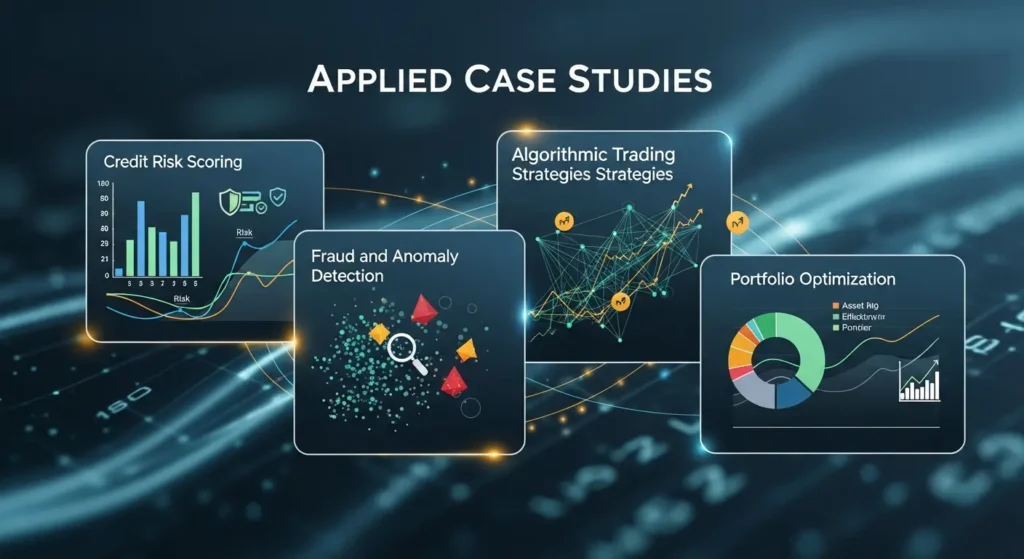- Introduction
- Importance of Machine Learning in Financial Engineering
- Core Machine Learning Methods Used in Finance
- Tools and Technologies
- Practical Learning and Hands-On Approach
- Applied Case Studies
- Top Machine Learning Projects for Practice
- Integration with Financial Engineering Concepts
- Skill Development and Career Outcomes
- Challenges and Future Outlook
- Conclusion
- FAQ
Introduction
Finance is becoming more data-driven every day. Banks, trading firms, and investment companies now work with massive amounts of data to make decisions. Because markets move fast and can be hard to predict, many professionals are turning to machine learning for financial engineering applications to uncover patterns and guide smarter strategies.
Machine learning helps computers learn from past data and improve their predictions. In financial engineering, this includes tasks such as forecasting stock trends, measuring risk, detecting fraud, and optimizing portfolios. Instead of depending only on traditional financial models, machine learning allows analysts to use real market behavior to find signals that may not be noticeable to humans.
As the financial industry grows more digital and competitive, understanding how to apply machine learning in finance is becoming an essential skill. It helps students, analysts, and professionals make clearer, faster, and more informed decisions in real-world financial situations.
Importance of Machine Learning in Financial Engineering
Financial markets change quickly and can be difficult to understand. Traditional statistical models may not capture sudden shifts or complex relationships between variables. Machine learning helps solve this by identifying patterns in large amounts of data.
Machine learning helps financial engineers:
- Predict market behavior more accurately
- Analyze risk and avoid major losses
- Create automated trading strategies
- Detect fraud in real time
- Support data-driven decision making
Compared to older methods, machine learning can learn from new data and adjust itself. This makes it useful in areas where market conditions constantly shift.
Core Machine Learning Methods Used in Finance
Supervised Learning
Supervised learning uses labeled data to predict outcomes. This is helpful in:
- Credit scoring and loan approval prediction
- Default and bankruptcy prediction
- Customer churn analysis
Models used include logistic regression, random forest, and gradient boosting frameworks such as XGBoost and LightGBM.
Unsupervised Learning
Unsupervised learning finds groups or patterns in unlabeled data. It is useful for:
- Customer segmentation in banking
- Fraud and anomaly detection
K-Means clustering is a common method here.
Predictive Modeling
Predictive models use time series data to forecast future values. Finance uses predictive modeling for:
- Stock price prediction
- Volatility forecasting
- Cryptocurrency price forecasting
Time series forecasting methods and LSTM-based neural networks are often used.
Tools and Technologies

Programming Language
Python is the most widely used programming language for machine learning in finance. It is easy to learn and has a rich ecosystem of data science tools.
Key Libraries
Important libraries include:
- NumPy and Pandas for handling data
- Scikit-learn for building classic models
- TensorFlow or PyTorch for deep learning tasks
Workflow
A typical workflow includes:
- Data preprocessing and cleaning
- Feature engineering
- Model training
- Model selection and evaluation
- Cross-validation to prevent overfitting
Understanding how to evaluate models is important because financial data can be noisy and unpredictable.
Practical Learning and Hands-On Approach
To gain real skills, students and professionals work on real financial datasets. This teaches them how to perform data cleaning, handle missing values, build models, and interpret results.
Key steps in developing a financial machine learning model:
- Collect and prepare data
- Build features that represent financial behavior
- Train the model and tune the parameters
- Validate using cross-validation techniques
- Check interpretability and avoid overfitting
Interpretation is critical because financial organizations must explain model decisions for regulatory compliance and risk control.
Applied Case Studies

Credit Risk Scoring
Models predict how likely a customer is to repay a loan.
Algorithmic Trading Strategies
Models analyze price movements and trigger buy or sell actions automatically.
Fraud and Anomaly Detection
Algorithms scan transactions and flag unusual activities quickly.
Portfolio Optimization
Machine learning helps balance risk and return when selecting assets.
Top Machine Learning Projects for Practice

Here are project ideas that help build real-world experience:
- Stock price prediction
- Time series forecasting
- Credit risk modeling
- Loan default prediction
- Customer segmentation using clustering
- Cryptocurrency price forecasting
- Fraud detection systems
- Customer churn prediction
These projects help build confidence and improve understanding of financial behavior.
Integration with Financial Engineering Concepts
Machine learning works best when combined with financial theory. Financial engineers apply knowledge about derivatives pricing, volatility models, and portfolio risk measures to choose the right features and interpret results.
For example:
- The Black-Scholes model is used with volatility estimation
- Delta hedging strategies can be simulated and analyzed
- Quantitative portfolio management benefits from predictive modeling
This combination helps create practical and reliable financial systems.
Skill Development and Career Outcomes
Learning machine learning in finance strengthens analytical thinking and programming skills. It prepares learners for roles such as:
- Quantitative Researcher
- Algorithmic Trader
- Risk Modeling Analyst
- Financial Data Scientist
These careers offer strong demand and growth opportunities in both banks and technology-driven financial firms.
Challenges and Future Outlook
Even though machine learning brings many benefits, there are challenges:
- Data quality can impact model accuracy
- Models must be transparent for regulatory approval
- Overfitting can cause poor real-world performance
In the future, deep learning and reinforcement learning will continue to expand in trading and risk management systems.
Conclusion
Machine learning is now a core part of financial engineering. It allows professionals to analyze data, make informed decisions, and build intelligent financial systems. With hands-on practice and strong foundational knowledge, learners can develop the skills needed to excel in a growing, data-driven financial world.
FAQ
What is machine learning used for in finance?
Machine learning is used to forecast trends, assess risk, detect fraud, and support trading decisions. It helps financial institutions work more accurately and efficiently.
Which machine learning algorithms are used in finance?
Common algorithms include logistic regression, random forests, XGBoost, and neural networks. K-Means is used for grouping customers, and LSTM networks are used for time series forecasting.
How is machine learning used in stock prediction?
Machine learning models look at past prices, trading volume, financial news, and market behavior. They use patterns in the data to predict future price movements.
What career roles involve machine learning in finance?
Roles include financial data scientist, quantitative analyst, algorithmic trader, and risk analyst.






